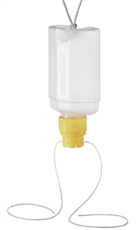What is Nipple Confusion?
Nipple confusion (aka nipple preference or feeding confusion) means an inability of a baby to effectively breastfeed following other methods of feeding or a pacifier use.
Nipple confusion is very individual. There are many possible circumstances that lead to it. Baby's behavior in these circumstances depends solely on the baby, his/her mood, temperament, and character.
Some babies are absolutely fine going back and forth between bottles, nipples, pacifiers, etc. For some it doesn’t matter who is giving them the bottle, how fast the flow is. Some are much more particular about who, when, how and why!
I tried to cover every possible aspect of nipple confusion below. There is no right or wrong method. If your baby is flexible in alternating real and artificial nipples – go with it. But if your little one is picky in his/her feeding habits (just like mine) try every idea I suggest. And here is to you - the proud Breastfeeder!!!
Avoid Nipple Confusion
Breastfeed your baby as soon and as often as possible after birth. Babies tend to be alert in the first hour, and then sleep most of the time during the first day of life. You need to manage to feed the baby during this first hour.
If due to complications of any sort you and your baby are separated, give instructions to the nurses to use feeding techniques other than the bottles. More on this later. If you are well, but unable to breastfeed, pump or hand express your colostrum or milk and supplement with it.
Avoid bottles at least until breastfeeding stabilizes (first week or two). Your baby’s mouth is extremely sensitive to textures and tastes during this time. Sucking on a bottle or a pacifier is different from sucking on the breast in terms of intensity, tongue position, and latch-on.
Milk or formula flow freely out of the bottle. Almost no effort is required on the part of the baby. Breast sucking requires a lot of work, especially before milk let-down. Less “hardworking” babies once introduced to a bottle, refuse to take the breast.
If you have to use bottle to supplement, choose the smallest flow nipple first. The idea is that you need to make bottle-sucking a hard work just like the breast.
If your need to supplement is not due to low milk supply, but the inability to breastfeed, pump you milk and supplement with it. There is nothing like mother’s milk for a baby. Every drop counts. Visit Breastfeeding Benefits section to read more.
If you decide to supplement with a bottle, ask someone else to give it to your baby. This way the baby will learn the rule: mommy got the breast, daddy got the bottle. It worked for my son. When I once gave him the bottle myself, it took a couple of breastfeeding sessions for him to get back on breastfeeding track.
Some doctors recommend introducing the bottle during the first month of breastfeeding when the breastfeeding is well established. I followed this advice and caused my son’s nipple confusion for the rest of my breastfeeding experience. If you are staying home with your baby and your breastfeeding is going well, DO NOT introduce the bottle to practice bottle-feeding.
If your baby is easy in terms of feeding habits, he will take the bottle just fine when needed. If he/she is picky, chances are he is prone to feeding confusion anyways. Why move it closer?
A Note on Pacifiers
Role of pacifiers in nipple confusion is debatable. I am sure you’ve heard some of your friends saying they were not going to give their babies pacifiers at all. Most of us still do.
Well, babies have a sucking reflex. Part of is satisfied with breastfeeding, the other part of it has to do with comforting themselves, soothing pains and discomforts. This other part gets satisfied with either a pacifier or wrist/fist/finger sucking.
If your baby refuses the pacifier, so be it. But the pacifier in the early days of baby’s life is nothing to be skeptical about. My son gave up the pacifier early, and a month later started sucking on two of his fingers. Now that is an undesirable outcome!
A pacifier can go away one day, be lost, be “taken by another little girl” – whatever works. My son’s fingers are always there, ready to be enjoyed!
I know some kids are more attached to the pacifier, some give it up easier – you’ll never know in advance. Don’t be all negative about giving your baby a pacifier. Here is what you need to consider, however:
- Wean from the pacifier early (ideally by the first tooth)
- Establish set rules when to use a pacifier: a little after the feeding, during the nap, after immunization shots, etc. My son was falling asleep with a pacifier and we were removing it shortly after that. Most of your baby’s day should be pacifier-free.
- Refrain from letting your baby suck on the pacifier before the feeding. This sucking may weaken hunger, and give you and the baby confusing signals.
When and How to Supplement?
Most of breastfeeding mothers do not truly need to supplement. If your need to supplement is due to low milk supply, work on your milk supply before giving up. Visit Increase Milk Supply sections to read more.
If you wish to supplement due to breast or nipple soreness, nipple inversion or other breastfeeding problems, visit Breastfeeding Problems section first.
Before opting for supplementation talk to a lactation consultant. Let someone who did it many times decide.
In some cases supplementation is unavoidable. Here is when:
- Mom’s previous breast reduction surgery. Visit Breast Implants section to read more.
- Prematurely born baby
- Difficulty gaining birth weight
- Jaundice (hyperbilirubinemia)
- Low blood sugar (hypoglycemia)
- Mature milk is delayed
- True low milk supply (diagnosed by a lactation specialist)
Supplementation with a bottle should be your last choice. Try one of these alternatives first.

SNS (Supplemental Nursing System) is a system consisting of a bottle and a thin tube. The tube is placed by the nipple. When the baby latches on the nipple, the tube is inserted in the corner of the baby’s mouth. SNS is breastfeeding-friendly. The baby is sucking on the breast and gets rewarded by a steady milk flow.
Finger method is used during the first days of baby’s life. A thin tube (possibly from a SNS device) is attached to the finger. The other end of the tube is attached to a bottle filled with supplemental milk. The baby is sucking on the finger and gets rewarded by the milk from the tube. Finger feeding is a temporary feeding solution.
Spoon method is another temporary method of supplementing breastfeeding. Some milk is paced onto a small spoon. Bring the spoon to the baby’s lower lip and let a drop of milk touch it. The baby should then open the mouth and swallow milk. Your baby should be alert and positioned upright.
Dropper method is when supplemental milk is given to the baby in a little dropper, like the one used for medications. The baby should be alert and positioned upright.
Syringe method is good for feeding slightly larger milk amounts than with a spoon or a dropper. A syringe is filled with milk. The baby should be alert and positioned upright. Let the milk flow slowly and allow time for the baby to swallow.
Cup feeding is feeding from a specially designed cup. Let the milk flow slowly, pause, and listen to the baby’s swallowing. The baby should be alert and happy to succeed with cup feeding.
All these methods may seem like too much work compared to bottles. However, nipple confusion is the highest with bottle-feeding. Exclusive breastfeeding is the winner. Next safest alternative is pumping or hand expressing your milk and supplementing with it through one of the methods listed above. Breastfeed this nipple confusion away!
There are many ways to show your love and devotion to your kids and to win their trust. Breastfeeding is the most natural one.
Yours,
Viktoriya
Back to top of Nipple Confusion>other Breastfeeding Problems> Breastfeeding Home










